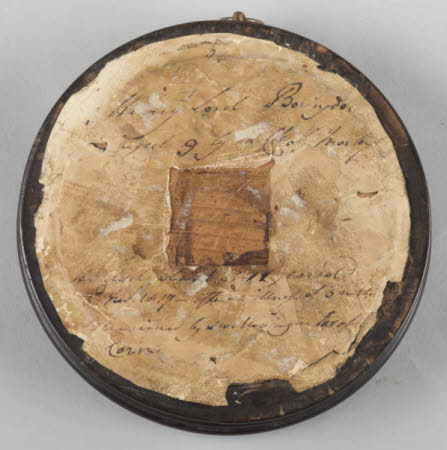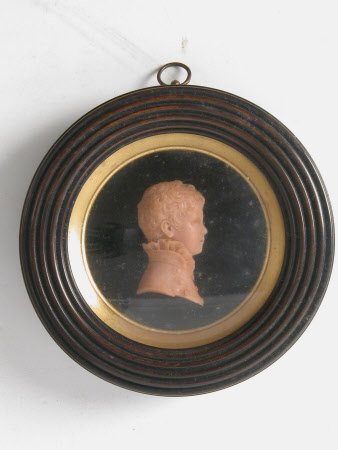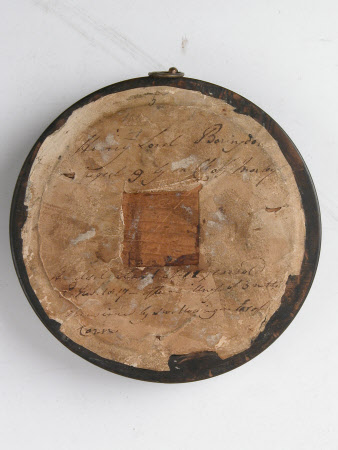Henry Villiers Parker, Viscount Boringdon
Frances Parker, Countess of Morley (Wymondham 1782 - ?Saltram 1857)
Category
Art / Sculpture
Date
1814 - 1817
Materials
Wax
Measurements
30 mm (Depth); 130 mm (Diameter)
Place of origin
England
Order this imageCollection
Osterley Park and House, London
NT 772581
Caption
Frances Talbot, Countess of Morley, was a talented amateur artist, illustrator and novelist. A portrait of Talbot in later life depicts her surrounded by these passions – she reads a book while a picture waits to be finished, or admired, on a table easel beside her. Aged 16, Talbot was awarded a silver medal in ‘polite arts’ by the Society for the Encouragement of Arts, Manufactures and Commerce (later the Royal Society of Arts) for her painting of Raphael’s Virgin and Child. In the following years she was awarded the larger silver palette medal for a painting after Titian, and a further silver medal for a painting of a ‘Herb Girl from nature’. These subjects suggest that Talbot was experimenting with painting figures – although, as a woman, she would not have been permitted to attend life-drawing classes to develop this skill. That constraint might explain why, during the Peace of Amiens, she went to Paris to study for a few months with the artist François Gérard (1770–1837), who was celebrated for his portraits of French nobility. A large collection of Talbot’s watercolours is held at Saltram in Devon, many showing scenes of continental Europe, including examples copied from artists such as William Callow and David Roberts. Talbot’s interest in wax modelling probably began following a visit to Saltram in 1813 by coloured-wax artist Samuel Percy (1750–1820). Talbot created a number of family portraits in this medium, including at least two copies of a tender image of her stepson, Henry Villiers Parker (1806–17), sculpted in 1814 before his tragic death, aged just 11. Talbot’s obituary in The Annual Register for 1857 creates a picture of a vibrant woman of wit and good conversation, making special note of her literary and artistic work – ‘a woman of strong mind and considerable literary and artistic abilities … [she] has left behind her a numerous collection of paintings, the product of her pencil’.
Summary
Wax relief portrait of Henry Villiers Parker, Viscount Boringdon (1806-1817) by his step-mother, Frances Parker, Countess of Morley (1782-1857), 1814-7. Profile portrait facing right, in turned circular frame with reeded profile, fitted with convex glass, below a gilt wood fillet. Contemporary gilt brass ring fixing at top. The back sealed with a contemporary vellum.
Full description
Henry Villiers Parker, Viscount Boringdon (1806-1817), was the son of John Parker, 1st Earl of Morley and his first wife Lady Augusta Fane (1786–1871). Henry died on 1 November 1817, aged 11, from the effects of swallowing an ear of corn while travelling on the Continent with his father and step-mother. He suffered for just over three months until he eventually died from an abscess in his lung. This wax portrait miniature was modeled in 1814, a few years before his death, by his step-mother, Frances Parker, Countess of Morley (1782-1857). The portrait is mentioned in 'Some Account of Lord Boringdon's Accident, on 21st July, 1817, and its consequences', London 1818, p. 16: 'The little wax model made of him by Lady Morley in 1814 was at the time, and continued to be, a strong likeness.' This was a published account of the accident, possibly written by Lady Morley herself. There is a manuscript copy of the 'Account' in the Jersey Papers at the London Metropolitan Archives (ACC 510/594). Frances Parker, Countess of Morley (1781-1857) was a talented amateur artist, skilled in oil and watercolour painting. As a young woman she won a number of premiums at the Society for the Encouragement of Artists for copies after works by Raphael and Titian. Her interest in wax modelling seems to have started following a visit in September 1813 from the well renowned wax modeller, Samuel Percy (1750-1820). Percy visited Saltram to model portraits of the Parker family and friends, but appeared to stay with the family for a few months. Percy, a Dubliner by birth, was an itinerant artist who had established himself as a leading modeller of coloured wax portraits (see NT 564569). He travelled extensively producing portraits of the gentry and nobility, and achieved the respected status as Wax Modeller to Princess Charlotte. It would appear that Percy taught Frances to model in wax during this time, and this miniature of Henry was possibly one of her first forays into wax modelling. Percy’s own miniatures of the Parker family taken at this time are untraced. There is another version of this portrait in white wax (Private Collection) as well as a portrait of Henry’s younger half-brother, Edmund, also modelled by Lady Morley. The portrait of Henry was presumably cast a number of times and distributed to various members of the family as was customary with wax portraits. Sarah Sophia Child Villiers, Countess of Jersey (1785 – 1867) was Henry's maternal Aunt, and was a frequent visitor to Saltram, the Parker family home, especially during the extended period of Henry's illness. It is likely that Lady Jersey was given a copy of the wax portrait by Lady Morley with the manuscript copy of 'Some Account of Lord Boringdon’s Accident'. It is possible that Lady Morley cast additional versions of the portrait after Henry’s death in 1817 as a memento of the young boy for close family. The Osterley version has a contemporary handwritten inscription on the reverse: ‘Henry Lord Boringdon/aged 9 by the Ctss of Morley//He died short of 11 years old/1 Nov. 1817 – after an illness of 3 months/occasioned by swallowing an Ear of/Corn.’ Anna Moore October 2017
Provenance
Modelled by Frances Parker, Countess of Morley (1782 - 1857) in 1814; probably given to Sarah Sophia Child-Villiers, Countess of Jersey (1785-1867) by Frances Parker, Countess of Morley c.1814-1817, possibly on the death of Lord Boringdon in 1817 (contemporary inscription on the reverse in the Countess of Morley's hand recounts the death of Lord Boringdon); by descent to George Child-Villiers, 9th Earl of Jersey (1910-1998); given to the National Trust in March 1993 by George Child-Villiers, 9th Earl of Jersey (1910-1998).
Credit line
National Trust Collections (Osterley Park, The Jersey Collection)
Marks and inscriptions
Reverse: ‘Henry Lord Boringdon/aged 9 by the Ctss of Morley//He died short of 11 years old/1 Nov. 1817 – after an illness of 3 months/occasioned by swallowing an Ear of/Corn.’
Makers and roles
Frances Parker, Countess of Morley (Wymondham 1782 - ?Saltram 1857), artist
References
Frances Parker, Countess of Morley?, Some Account of Lord Boringdon's Accident, on 21st July, 1817, and its consequences, London 1818, p.16 Conroy, Rachel, Women Artists and Designers at the National Trust, 2025, pp. 100-103



